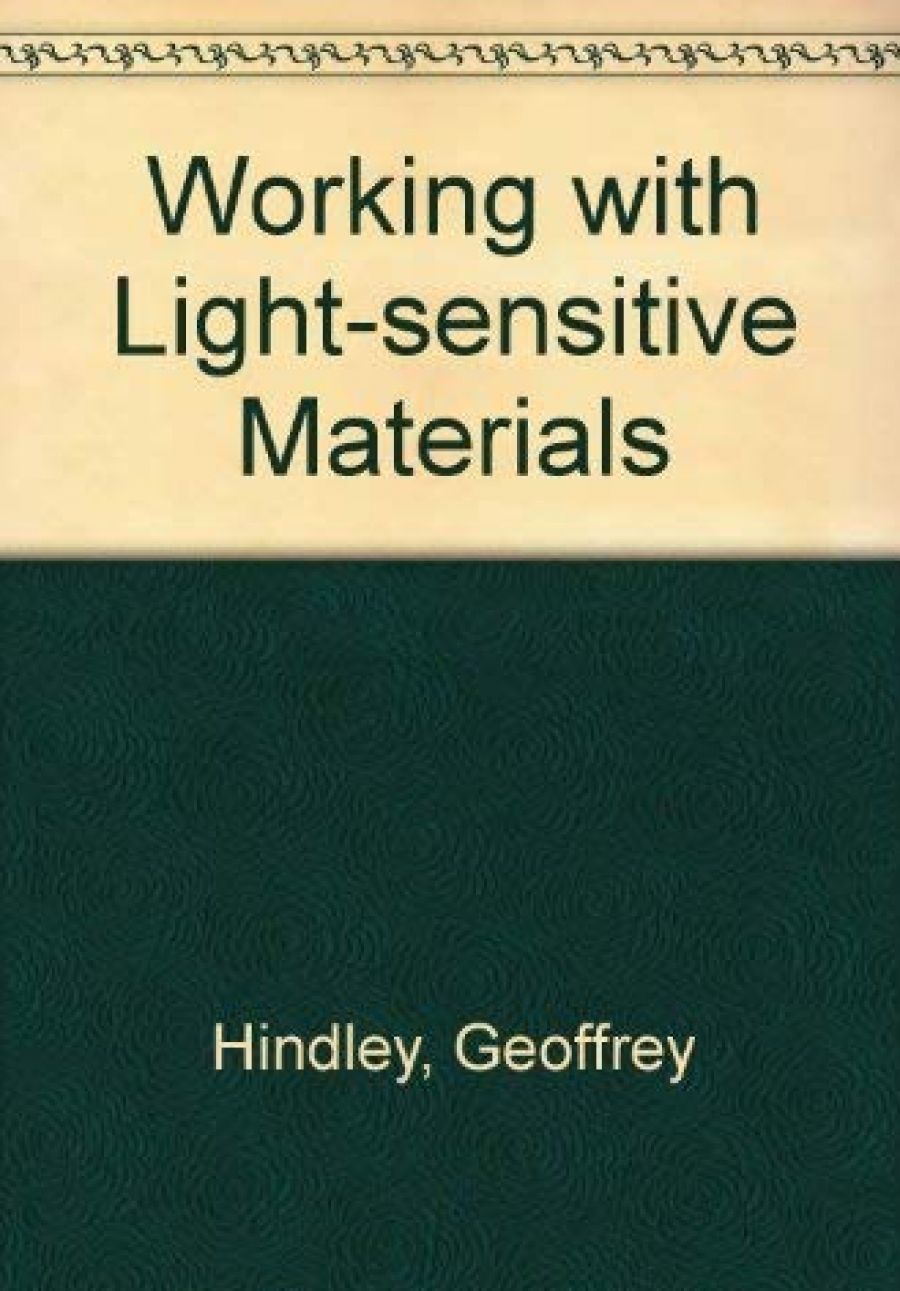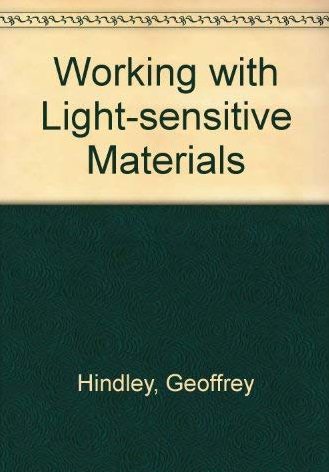
- Free Article: No
- Contents Category: Photography
- Review Article: Yes
- Article Title: Working with Light Sensitive Materials
- Online Only: No
- Custom Highlight Text:
The photograph is our time’s supreme form of self-expression. Wherever we look, we are surrounded by photographs – in books, on posters, in magazines, newspapers, packaging, and of course in films and television. The photograph is universally understandable and so appears not to need explanation to supplement it. Its power to convey experience increases as superfluous details are eliminated. And it attains its highest potential when the representation becomes purely symbolic.
- Book 1 Title: Working with Light Sensitive Materials
- Book 1 Biblio: Van Nostrand Reinhold, $6.95, 96 pp
- Book 1 Cover Small (400 x 600):

- Book 1 Cover (800 x 1200):

Geoffrey Hindley’s Working with Light Sensitive Materials introduces, in simple terms, two closely related areas – basic photography and silkscreen printing – which should be of interest to the enthusiastic amateur and the artist in Fine and Graphic Art.
In chapter one of this very practical handbook, the reader is given a brief insight to the history of photography. The actual forming of images by the direct action of light was well – known long before the discovery of lightsensitive[original does not hyphenate] materials on which they could be recorded. As early as 1520, Leonardo da Vinci (and even before him Roger Bacon) had observed that images of objects could be reflected in a dark chamber. In the course of the following three centuries Porta, Schulze, Scheele and Wedgwood, to name but a few, contributed discoveries and improvements to the method of arresting images by means of light. But it was only in the late 1820s that the Frenchmen Niecephore Niepce and Louis Jacques Mande Daguerre perfected methods which are the prototype of contemporary photography. In 1889, Eastman introduced celluloid film, which was invented by Goodman two years previously, making photography economically accessible to the general public.
The appeal of realism, the desire to obtain accurate likeness, supplied the impetus for the development of the photographic image. As a fine art, it has progressed from the simple objective of recording nature to the wider range that camera angle, ultra close-ups, photograms and photo-montage have made possible.
Today the lens penetrates beyond mere externals. Instead of depending on accidental results, the contemporary photographic artist has learned to select, to arrange, and to interpret. Like other contemporary artists, he has dared to employ unusual points of view, to free himself from set dicta, and to emphasise expressionism, or impressionism if the artist preferred, over literal transcription.
The implication behind Mr Hindley’s book is that modern photography and the art of silkscreen printing should be studied with the same thoroughness as painting. Its art employs the same principles of composition. It is necessary to divide a given space, whether canvas or photographic lightsensitive materials, into parts that form an interesting and harmonious whole; to arrange the pattern of light and dark pleasingly, and to maintain a dominant point of interest with well correlated subordinates. One learns through repeated efforts, with the use of the utmost care in both mechanical process and composition, although many artists are impressed as much by subject appeal as by composition.
The general practice of employing photographic tricks, such as unnatural lighting and the over-use of e.g. soft-focus effects, does not necessarily displace good design. Knowledge of techniques is valuable, but superior skill cannot cover up inferior art. The result must still be judged for its artistic merit, largely by principles of composition.
But the artist with a camera applying himself to the silkscreen process must also be familiar with the many variations available to him in terms of subject matter, lighting, shutters, lenses, cameras, papers, developers, panchromatic and Graphic Arts films, stencils, wax, crayons, the different screen materials, etc., etc.
All these things combined become the language of the potential creative artist. To speak this language he must have a suitable number of these methods and materials in his vocabulary, not for mere conversation purposes but to enhance his total thinking process. Working with Light Sensitive Materials certainly encourages the serious reader a long way in this direction.
The book could also well be of great use to the primary and/or secondary schooleducationist. It brings to mind, for example, to what extent active involvement with photography should become an integral part of the school education process. Should it, for instance, become a part of the general school curriculum in secondary, or even in primary level?
Photography as a skill certainly provides many positive factors in the educational process. It tends to change the role of teacher and student, making a participant instead merely an observer out of that student. According to overseas studies, notably in the United States, photography provides a unique means for developing the assertiveness, the independence and sense of identity so crucial to a positive self-image.
In a society in which children sit entranced for thousands of hours before hypnotic, commercially oriented television, a working knowledge of photography can be a survival tool.
Dr Edward Bernard, adjunct professor of education at the Graduate Division of Hunter College (US), points out that such things as television commercials are used to convey, manipulate, and often distort meanings. So, it is essential that children have a knowledge of how images are used in this way to defend themselves against pictorial presentation which is attempting to exert influence. Without a knowledge of the process by which these pervasive commercial influences are made, he adds, the child may never even become aware of their manipulative potential.
Mr Hindley, after a few helpful suggestions on how to set up a rather elaborate darkroom, continues to get us acquainted (unfortunately all too briefly), with a fascinating subject matter: that of the photogram. To most people seriously interested in the photographic medium, the idea of making a record of an image without the use of a camera will sooner or later occur.
The detailed information of an insect’s wing put into the enlarger’s negative carrier, a delicately formed piece of lacework placed on bromide paper and then exposed to a light source will produce results of typically photographic quality, generally called photograms –photographically recorded shadow. The clarity and economy of these elementary photograms is often striking, as some of the samples reproduced in the book show. Their visual impact is due to the fact that they stress an aspect of reality not generally seen, and that they sometimes reveal more of the true nature of an object than any straight photograph, concerned merely with the play of light on its external surface.
The possible variations of the photogram technique are as unlimited as the number of objects which will yield interesting photograms.
A brief explanation of how shadow quality is on the size and placing of the light-source in relation to the object, and on the distance from the object to the surface upon which the shadow falls; that tonal relationships may be altered at will by changing exposure and development; or that photogram images can be combined either with each other or with normal photographic images through multi-exposure, would have been a welcome gesture to stimulate the interested reader into further experimentation.
Contrary to the somewhat lack-lustre introduction to the photogram technique, the following chapters discussing the different photographic materials – black and white Panchromatic films, introduction to Graphic Arts film, a fairly easy method of preparing a photographic emulsion, the construction of pinhole cameras with and without simple lenses (and their possible uses) – are packed with practical, technical and often creative information and ideas. The explanatory photographs and diagrams are simple compositions, well-drawn and easy to follow visual statements accompanying a straightforward, clearly written text.
The mind boggles if one thinks through the possibilities in the creative/ experimental field of photography using the 360 degrees pinhole camera.
The final chapters deal with basic screen printing. The great advantage of this process is that its images can be printed on a great variety of surfaces, providing these are fairly flat and smooth (there are exceptions).
Many artists and photographers at present are experimenting with the possibility of combining the photographic process with the silkscreen process. The outcome of the resulting images is a stimulating combination of the detail and accuracy of reproduction through photographs, with the incredible flexibility in colour manipulation of the silkscreen process. It is therefore understandable why, coupled with the relative simplicity of operation, photographers and artists alike are encouraged by Mr Hindley to see its potential as a unique form of visual expression.
Working with Light Sensitive Materials is a well-rounded, practically oriented handbook, explaining in detail both the photographic and silkscreen processes. Although the book intends the two creative methods to be combined ultimately into a whole, the photographer or the Graphic Artist could utilise either section as a starting point.


Comments powered by CComment